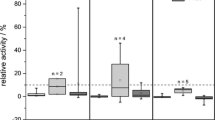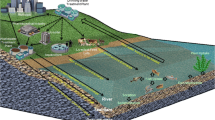Abstract
Endocrin-disrupting compounds (EDCs) are frequently found in wastewater treatment plants (WWTPs). So far, research has been mainly focused on the detection of estrogenic compounds and very little work has been carried out on other receptors activators. In this study, we used reporter cell lines, which allow detecting the activity of estrogen (ERα), androgen (AR), pregnane X (PXR), glucocorticoid (GR), progesterone (PR), mineralocorticoid (MR), and aryl hydrocarbon (AhR) receptors, to characterise the endocrine-disrupting profile of the aqueous, suspended particulate matter, and sludge fractions from three Tunisian WWTPs. The aqueous fraction exhibited estrogenic and androgenic activities. Suspended particulate matter and sludge extracts showed estrogenic, aryl hydrocarbon and pregnane X receptor activities. No GR, MR, or PR (ant) agonistic activity was detected in the samples, suggesting that environmental compounds present in sewage might have a limited spectrum of activity. By performing competition experiments with recombinant ERα, we demonstrated that the estrogenic activity detected in the aqueous fraction was due to EDCs with a strong affinity for ERα. Conversely, in the sludge fraction, it was linked to the presence of EDCs with weak affinity. Moreover, by using different incubation times, we determined that the EDCs present in suspended particulate matter and sludge, which can activate AhR, are metabolically labile compounds. Finally, we showed in this study that environmental compounds are mainly ER, AR, PXR, and AhR activators. Concerning AR and PXR ligands, we do not to know the nature of the molecules. Concerning ER and AhR compounds, competition experiments with recombinant receptor and analysis at different times of exposure of the AhR activation gave some indications of the compound’s nature that need to be confirmed by chemical analysis.









Similar content being viewed by others
References
Aerni H-R, Kobler B, Rutishauser B, Wettstein F, Fischer R, Giger W et al (2004) Combined biological and chemical assessment of estrogenic activities in wastewater treatment plant effluents. Anal Bioanal Chem 378:1873
Balaguer P, Boussioux AM, Demirpence E, Nicolas JC (2001) Reporter cell lines are useful tools for monitoring biological activity of nuclear receptor ligands. Luminescence 16:153–158
Balaguer P, Francois F, Comunale F, Fenet H, Boussioux AM, Pons M et al (1999) Reporter cell lines to study the estrogenic effects of xenoestrogens. Sci Total Environ 233:47–56
Baronti C, Curini R, D’Ascenzo G, Di Corcia A, Gentili A, Samperi R (2000) Monitoring natural and synthetic estrogens at activated sludge sewage treatment plants and in a receiving river water. Environ Sci Technol 34:5059–5066
Bila D, Montalvao AF, Azevedo Dde A, Dezotti M (2007) Estrogenic activity removal of 17beta-estradiol by ozonation and identification of by-products. Chemosphere 69:736–746
Chang H, Hu J, Shao B (2007) Occurrence of natural and synthetic glucocorticoids in sewage treatment plants and receiving river waters. Environ Sci Technol 41:3462–3468
Creusot N, Kinani S, Balaguer P, Tapie N, Maillot-Maréchal E, Porcher JM, Budzinski H, Aït-Aïssa S (2010) Evaluation of an hPXR reporter gene assay for the detection of aquatic emerging pollutants: screening of chemicals and application to water samples. Anal Bioanal Chem. doi:10.1007/s00216-009-3310-y
D’Ascenzo G, Di Corcia A, Gentili A, Mancini R, Mastropasqua R, Nazzari M, Samperi R (2003) Fate of natural estrogen conjugates in municipal sewage transport and treatment facilities. Sci Total Environ 302:199–209
Dagnino S, Picot B, Escande A, Balaguer P, Fenet H (2009) Occurrence and removal of endocrine disrupters in waste water treatment plants for small communities. DesWater 4:93–97
Desbrow C, Routledge EJ, Brighty GC, Sumpter JP, Waldock M (1998) Identification of estrogenic chemicals in STW effluent. 1. Chemical fractionation and in vitro biological screening. Environ Sci Technol 32:1549–1558
Fenet H, Gomez E, Pillon A, Rosain D, Nicolas JC, Casellas C et al (2003) Estrogenic activity in water and sediments of a French river: contribution of alkylphenols. Arch Environ Contam Toxicol 44:1–6
Fernandez MP, Buchanan ID, Ikonomou MG (2008) Seasonal variability of the reduction in estrogenic activity at a municipal WWTP. Water Res 42:3075–3081
Fernandez MP, Ikonomou MG, Buchanan I (2007) An assessment of estrogenic organic contaminants in Canadian wastewaters. Sci Total Environ 373:250–269
Gomez E, Wang X, Dagnino S, Leclercq M, Escande A, Casellas C, Picot B, Fenet H (2007) Fate of endocrine disrupters in waste stabilization pond systems. Water Sci Technol 55:157–163
Grün F, Blumberg B (2006) Environmental obesogens: organotins and endocrine disruption via nuclear receptor signaling. Endocrinology 147:50–55
Harries JE, Janbakhsh A, Jobling S, Matthiessen P, Sumpter JP, Tyler CR (1999) Estrogenic potency of effluent from two sewage treatment works in the united kingdom. Environ Toxicol Chem 18:932–937
Hernandez-Raquet G, Soef A, Delgenes N, Balaguer P (2007) Removal of the endocrine disrupter nonylphenol and its estrogenic activity in sludge treatment processes. Water Res 41:2643–2651
Jobling S, Beresford N, Nolan M, Rodgers-Gray T, Brighty GC, Sumpter JP, Tyler CR (2002) Altered sexual maturation and gamete production in wild roach (Rutilus rutilus) living in rivers that receive treated sewage effluents. Biol Reprod 66:272–281
Johnson AC, Aerni HR, Gerritsen A, Gibert M, Giger W, Hylland K et al (2005) Comparing steroid estrogen, and nonylphenol content across a range of European sewage plants with different treatment and management practices. Water Res 39:47–58
Jones JM, Anderson JW, Tukey RH (2000) Using the metabolism of PAHs in a human cell line to characterize environmental samples. Environ Toxicol Pharmacol 8:119–126
Kavlock RJ, Daston GR, DeRosa C, Fenner-Crisp P, Gray LE, Kaattari S et al (1996) Research needs for the risk assessment of health and environmental effects of endocrine disruptors: A report of the U.S. EPA-sponsored workshop. Environ Health Perspect 104:715–740
Kim SD, Cho J, Kim IS, Vanderford BJ, Snyder SA (2007) Occurrence and removal of pharmaceuticals and endocrine disruptors in South Korean surface, drinking, and waste waters. Water Res 41:1013–1021
Kinani S, Bouchonnet S, Creusot N, Bourcier S, Balaguer P, Porcher JM, Aït-Aïssa S (2010) Bioanalytical characterisation of multiple endocrine- and dioxin-like activities in sediments from reference and impacted small rivers. Environ Pollut 158:74–83
Kirk LA, Tyler CR, Lye CM, Sumpter JP (2002) Changes in estrogenic and androgenic activities at different stages of treatment in wastewater treatment works. Environ Toxicol Chem 21:972–979
Körner W, Hanf V, Schuller W, Kempter C, Metzger J, Hagenmaier H (1999) Development of a sensitive E-screen assay for quantitative analysis of estrogenic activity in municipal sewage plant effluents. Sci Total Environ 225:33–48
le Maire A, Grimaldi M, Roecklin D, Dagnino S, Vivat-Hannah V, Balaguer P, Bourguet W (2009) Activation of RXR-PPAR heterodimers by organotin environmental endocrine disruptors. EMBO Rep 10:367–373
Lee HB, Peart TE, Chan J, Gris G (2004) Occurrence of endocrine-disrupting chemicals in sewage and sludge samples in Toronto, Canada. Water Qual Res J Canada 39:57–63
Lemaire G, de Sousa G, Rahmani R (2004) A PXR reporter gene assay in a stable cell culture system: CYP3A4 and CYP2B6 induction by pesticides. Biochem Pharmacol 68:2347–2358
Lemaire G, Mnif W, Pascussi JM, Pillon A, Rabenoelina F, Fenet H, Gomez E, Casellas C, Nicolas JC, Cavailles V, Duchesne MJ, Balaguer P (2006) Identification of new human pregnane X receptor ligands among pesticides using a stable reporter cell system. Toxicol Sci 91:501–509
Leusch FDL, Chapman HF, van den Heuvel MR, Tan BLL, Gooneratne SR, Tremblay LA (2006) Bioassay-derived androgenic and estrogenic activity in municipal sewage in Australia and New Zealand. Ecotoxicol Environ Safety 65:403–411
Li J, Ma M, Wang Z (2010) In vitro profiling of endocrine disrupting effects of phenols. Toxicol In Vitro. doi:10.1016/j.tiv.2009.09.008
Liu ZH, Ito M, Kanjo Y, Yamamoto A (2009) Profile and removal of endocrine disrupting chemicals by using an ER/AR competitive ligand binding assay and chemical analyses. J Environ Sci 21:900–906
Louiz I, Kinani S, Gouze ME, Ben-Attia M, Menif D, Bouchonnet S et al (2008) Monitoring of dioxin-like, estrogenic and anti-androgenic activities in sediments of the Bizerta lagoon (Tunisia) by means of in vitro cell-based bioassays: contribution of low concentrations of polynuclear aromatic hydrocarbons (PAHs). Sci Total Environ 402:318–329
Machala M, Vondrácek J, Bláha L, Ciganek M, Neca J (2001) Aryl hydrocarbon receptor-mediated activity of mutagenic polycyclic aromatic hydrocarbons determined using in vitro reporter gene assay. Mutat Res Gen Toxicol Environ 497:49–62
Mnif W, Pascussi JM, Pillon A, Escande A, Bartegi A, Nicolas JC et al (2007) Estrogens and antiestrogens activate hPXR. Toxicol Lett 170:19–29
Molina-Molina JM, Hillenweck A, Jouanin I, Zalko D, Cravedi JP, Fernandez MF et al (2006) Steroid receptor profiling of vinclozolin and its primary metabolites. Toxicol Appl Pharmacol 216:44–54
Noppe H, Verslycke T, De Wulf E, Verheyden K, Monteyne E, Van Caeter P et al (2007) Occurrence of estrogens in the Scheldt estuary: a 2-year survey. Ecotoxicol Environ Safety 66:1–8
Okada H, Tokunaga T, Liu X, Takayanagi S, Matsushima A, Shimohigashi (2008) Direct evidence revealing structural elements essential for the high binding ability of bisphenol A to human estrogen-related receptor-gamma. Environ Health Perspect 116:32–38
Patureau D, Hernandez-Raquet G, Balaguer P, Delgenes N, Muller M, Dagnino S et al (2008) Relevant approach to assess performances of wastewater biosolids composting in terms of micropollutants removal. Water Sci Technol 58:45–52
Pillon A, Boussioux AM, Escande A, Ait-Aissa S, Gomez E, Fenet H et al (2005) Binding of estrogenic compounds to recombinant estrogen receptor-alpha: application to environmental analysis. Environ Health Perspect 113:278–284
Purdom CE, Hardiman PA, ByeVV J, Eno NC, Tyler CR, Sumpter JP (1994) Estrogenic effects of effluents from sewage treatment works. Chem Ecol 8:275–285
Riu A, Balaguer P, Perdu E, Pandelova M, Piccinelli R, Gustafsson JA et al (2008) Characterisation of bioactive compounds in infant formulas using immobilised recombinant estrogen receptor-alpha affinity columns. Food Chem Toxicol 46:3268–3278
Routledge EJ, Sheahan D, Desbrow C, Brighty GC, Waldock M, Sumpter JP (1998) Identification of estrogenic chemicals in STW effluent. 2. In vivo responses in trout and roach. Environ Sci Technol 32:1559–1565
Soto AM, Sonnenschein C, Chung KL, Fernandez MF, Olea N, Serrano FO (1995) The E-SCREEN assay as a tool to identify estrogens: an update on estrogenic environmental pollutants. Environ Health Perspect 103(Suppl 7):113–122
Stasinakis AS, Gatidou G, Mamais D, Thomaidis NS, Lekkas TD (2008) Occurrence and fate of endocrine disrupters in Greek sewage treatment plants. Water Res 42:1796–1804
Svenson A, Allard AS, Ek M (2003) Removal of estrogenicity in Swedish municipal sewage treatment plants. Water Res 37:4433–4443
Tan BL, Hawker DW, Muller JF, Leusch FD, Tremblay LA, Chapman HF (2007) Comprehensive study of endocrine disrupting compounds using grab and passive sampling at selected wastewater treatment plants in South East Queensland, Australia. Environ Int 33:654–669
Ternes TA, Stumpf M, Mueller J, Haberer K, Wilken RD, Servos M (1999a) Behavior and occurrence of estrogens in municipal sewage treatment plants. I. Investigations in Germany, Canada and Brazil. Sci Total Environ 225:81–90
Ternes TA, Kreckel P, Mueller J (1999b) Behaviour and occurrence of estrogens in municipal sewage treatment plants. II. Aerobic batch experiments with activated sludge. Sci Total Environ 225:91–99
Terouanne B, Tahiri B, Georget V, Belon C, Poujol N, Avances C et al (2000) A stable prostatic bioluminescent cell line to investigate androgen and antiandrogen effects. Mol Cell Endocrinol 160:39–49
van der Linden SC, Heringa MB, Man HY, Sonneveld E, Puijker LM, Brouwer A et al (2008) Detection of multiple hormonal activities in wastewater effluents and surface water, using a panel of steroid receptor CALUX bioassays. Environ Sci Technol 42:5814–5820
Willemsen P, Scippo ML, Kausel G, Figueroa J, Maghuin-Rogister G, Martial JA, Muller M (2004) Use of reporter cell lines for detection of endocrine-disrupter activity. Anal Bioanal Chem 378:655–663
Acknowledgments
This study was co-funded by the Tunisian Ministry for the Scientific Research, the Technology and the Development of Competences, to the Research Unit 02/UR/09-01 of the Higher Institute of Biotechnology of Monastir, and by the Embassy of France in Tunisia/EGIDE Montpellier, France (SSHN, 2008). WM is currently at the Department of Biology of the Higher Institute of Biotechnology of Sidi Thabet, University of Manouba, Tunisia.
Author information
Authors and Affiliations
Corresponding author
Additional information
P. Balaguer and A. Bartegi should be considered as last co-authors.
Rights and permissions
About this article
Cite this article
Mnif, W., Dagnino, S., Escande, A. et al. Biological Analysis of Endocrine-Disrupting Compounds in Tunisian Sewage Treatment Plants. Arch Environ Contam Toxicol 59, 1–12 (2010). https://doi.org/10.1007/s00244-009-9438-0
Received:
Accepted:
Published:
Issue Date:
DOI: https://doi.org/10.1007/s00244-009-9438-0




